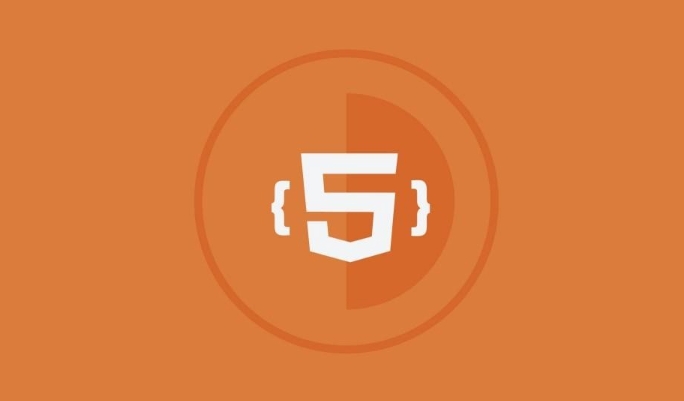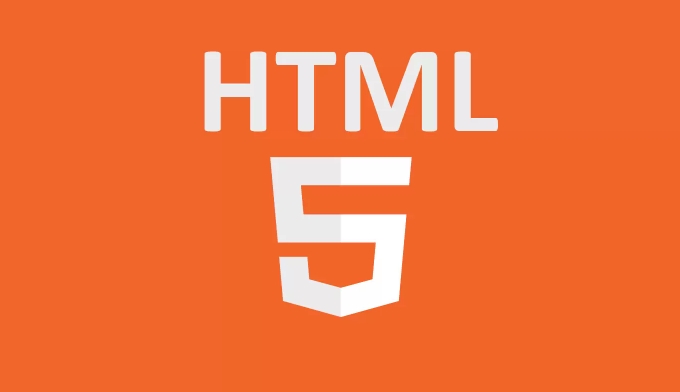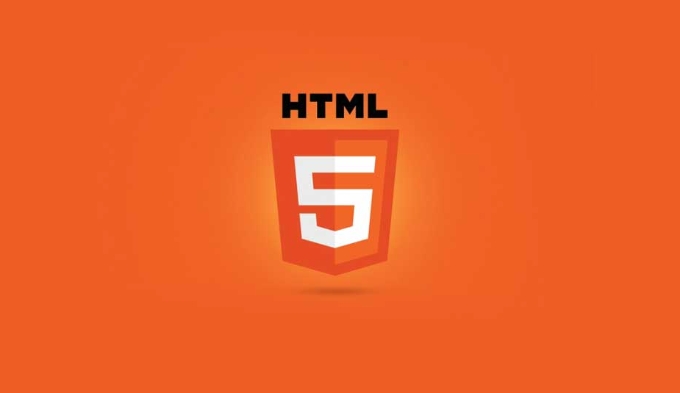Using HTML5's <header> and <footer> elements can improve the clarity and accessibility of web page structure. <header> is usually located at the top of a page or block, and contains introductory content such as site titles, navigation menus or banners; <footer> is often located at the bottom, placing copyright information, contact information or secondary navigation links. Both can be used multiple times and content relevance is required. They support CSS style settings such as background color, margins, and text alignment to enhance visual distinction. However, not all pages must contain these two elements. Simple pages can be omitted according to actual needs, while standard web pages are recommended to improve user experience and SEO results.

When you're building a webpage with HTML5, using the right semantic elements make your code clearer and more accessible. Two of the most useful tags for structuring your page are <header></header> and <footer></footer> . These aren't just for looks — they help browsers, screen readers, and search engines understand what part of the page they're dealing with.
 ` and `<footer> `." />
` and `<footer> `." /> What goes inside a <header></header> ?
A <header></header> typically sits at the top of a page or section and contains introduction content. It's common to include things like:
- The site logo or title
- Navigation menus
- A banner image or heading
You can use it at the top of the whole page, or even inside individual sections or articles. Just keep in mind that each <header></header> should be relevant to the section it belongs to.
 ` and `<footer> `." />
` and `<footer> `." />For example:
<header>
<h1>My Website</h1>
<nav>
<ul>
<li><a href="/">Home</a></li>
<li><a href="/about">About</a></li>
</ul>
</nav>
</header>This structure is clean and tells both users and tools that this area is the top part of your page.
 ` and `<footer> `." />
` and `<footer> `." /> What belongs in a <footer> ?
The <footer> usually appears at the bottom of a page or section, and it often includes:
- Copyright info
- Contact details
- Social media links
- Secondary navigation
Like <header> , a <footer> can be used more than once — for example, at the bottom of a blog post or at the end of the entire website.
Here's a basic example:
<footer>
<p>© 2025 My Website. All rights reserved.</p>
<ul>
<li><a href="/contact">Contact</a></li>
<li><a href="/privacy">Privacy Policy</a></li>
</ul>
</footer>Just make sure not to put unrelated stuff in there. Stick to closing information or links that help wrap up the page.
Can I style them with CSS?
Yes, absolutely. Since <header> and <footer> are block-level elements, you can style them just like any other <div> . For instance, you might want to center the text in your footer or give your header a background color.
Some common styling tips:
- Use
margin: 0 autoto center align your header or footer content - Add padding so text doesn't stick to the edge
- Set background colors or borders to visually separate these sections
Example:
header {
background-color: #f5f5f5;
padding: 20px;
text-align: center;
}
footer {
font-size: 0.9em;
color: #666;
padding: 15px;
}These styles help make those areas stand out without being too flashy.
Do I need both on every page?
Not necessary. Some pages, especially simple ones like a thank-you screen or an error page, might not need a full header or footer. But for most standard web pages — especially blogs, business sites, or portfolios — including both helps with usability and SEO.
If you're leaving one out, ask yourself: does the user know where they are and how to get around? If not, consider adding at least a basic version.
That's the basics of using <header></header> and <footer></footer> in HTML5. They're straightforward but powerful tools for organizing your content and making your site easier to navigate.
The above is the detailed content of Defining page headers and footers with HTML5 `` and ``.. For more information, please follow other related articles on the PHP Chinese website!

Hot AI Tools

Undress AI Tool
Undress images for free

Undresser.AI Undress
AI-powered app for creating realistic nude photos

AI Clothes Remover
Online AI tool for removing clothes from photos.

Clothoff.io
AI clothes remover

Video Face Swap
Swap faces in any video effortlessly with our completely free AI face swap tool!

Hot Article

Hot Tools

Notepad++7.3.1
Easy-to-use and free code editor

SublimeText3 Chinese version
Chinese version, very easy to use

Zend Studio 13.0.1
Powerful PHP integrated development environment

Dreamweaver CS6
Visual web development tools

SublimeText3 Mac version
God-level code editing software (SublimeText3)
 Using ARIA attributes with HTML5 semantic elements for accessibility
Jul 07, 2025 am 02:54 AM
Using ARIA attributes with HTML5 semantic elements for accessibility
Jul 07, 2025 am 02:54 AM
The reason why ARIA and HTML5 semantic tags are needed is that although HTML5 semantic elements have accessibility meanings, ARIA can supplement semantics and enhance auxiliary technology recognition capabilities. For example, when legacy browsers lack support, components without native tags (such as modal boxes), and state updates need to be dynamically updated, ARIA provides finer granular control. HTML5 elements such as nav, main, aside correspond to ARIArole by default, and do not need to be added manually unless the default behavior needs to be overridden. The situations where ARIA should be added include: 1. Supplement the missing status information, such as using aria-expanded to represent the button expansion/collapse status; 2. Add semantic roles to non-semantic tags, such as using div role to implement tabs and match them
 Integrating CSS and JavaScript effectively with HTML5 structure.
Jul 12, 2025 am 03:01 AM
Integrating CSS and JavaScript effectively with HTML5 structure.
Jul 12, 2025 am 03:01 AM
HTML5, CSS and JavaScript should be efficiently combined with semantic tags, reasonable loading order and decoupling design. 1. Use HTML5 semantic tags, such as improving structural clarity and maintainability, which is conducive to SEO and barrier-free access; 2. CSS should be placed in, use external files and split by module to avoid inline styles and delayed loading problems; 3. JavaScript is recommended to be introduced in front, and use defer or async to load asynchronously to avoid blocking rendering; 4. Reduce strong dependence between the three, drive behavior through data-* attributes and class name control status, and improve collaboration efficiency through unified naming specifications. These methods can effectively optimize page performance and collaborate with teams.
 HTML5 video not playing in Chrome
Jul 10, 2025 am 11:20 AM
HTML5 video not playing in Chrome
Jul 10, 2025 am 11:20 AM
Common reasons why HTML5 videos don't play in Chrome include format compatibility, autoplay policy, path or MIME type errors, and browser extension interference. 1. Videos should be given priority to using MP4 (H.264) format, or provide multiple tags to adapt to different browsers; 2. Automatic playback requires adding muted attributes or triggering .play() with JavaScript after user interaction; 3. Check whether the file path is correct and ensure that the server is configured with the correct MIME type. Local testing is recommended to use a development server; 4. Ad blocking plug-in or privacy mode may prevent loading, so you can try to disable the plug-in, replace the traceless window or update the browser version to solve the problem.
 Embedding video content using the HTML5 `` tag.
Jul 07, 2025 am 02:47 AM
Embedding video content using the HTML5 `` tag.
Jul 07, 2025 am 02:47 AM
Embed web videos using HTML5 tags, supports multi-format compatibility, custom controls and responsive design. 1. Basic usage: add tags and set src and controls attributes to realize playback functions; 2. Support multi-formats: introduce different formats such as MP4, WebM, Ogg, etc. through tags to improve browser compatibility; 3. Custom appearance and behavior: hide default controls and implement style adjustment and interactive logic through CSS and JavaScript; 4. Pay attention to details: Set muted and autoplay to achieve automatic playback, use preload to control loading strategies, combine width and max-width to achieve responsive layout, and use add subtitles to enhance accessibility.
 Using HTML5 Semantic Elements for Page Structure
Jul 07, 2025 am 02:53 AM
Using HTML5 Semantic Elements for Page Structure
Jul 07, 2025 am 02:53 AM
Using HTML5 semantic tags can improve web structure clarity, accessibility and SEO effects. 1. Semantic tags such as,,,, and make it easier for the machine to understand the page content; 2. Each tag has a clear purpose: used in the top area, wrap navigation links, include core content, display independent articles, group relevant content, place sidebars, and display bottom information; 3. Avoid abuse when using it, ensure that only one per page, avoid excessive nesting, reasonable use and in blocks. Mastering these key points can make the web page structure more standardized and practical.
 Explaining the HTML5 `` vs `` elements.
Jul 12, 2025 am 03:09 AM
Explaining the HTML5 `` vs `` elements.
Jul 12, 2025 am 03:09 AM
It is a block-level element, suitable for layout; it is an inline element, suitable for wrapping text content. 1. Exclusively occupy a line, width, height and margins can be set, which are often used in structural layout; 2. No line breaks, the size is determined by the content, and is suitable for local text styles or dynamic operations; 3. When choosing, it should be judged based on whether the content needs independent space; 4. It cannot be nested and is not suitable for layout; 5. Priority is given to the use of semantic labels to improve structural clarity and accessibility.
 Accessing User Location with HTML5 Geolocation API
Jul 07, 2025 am 02:49 AM
Accessing User Location with HTML5 Geolocation API
Jul 07, 2025 am 02:49 AM
To obtain user location information, you must first obtain authorization. When using HTML5's GeolocationAPI, the first step is to request user permission. If the user refuses or fails to respond, an error should be handled and a prompt should be given; after successful authorization, the Position object includes coords (latitude, longitude, etc.) and timestamp; you can use watchPosition to monitor location changes, but you need to pay attention to performance issues and clear the listener in time. 1. Authorization requires the user to explicitly allow it to trigger the getCurrentPosition method request; 2. Process error.code when rejected or errored and prompt the user; 3. After success, position.coords provides location data; 4.watc
 Saving the content of an HTML5 canvas as an image.
Jul 08, 2025 am 02:13 AM
Saving the content of an HTML5 canvas as an image.
Jul 08, 2025 am 02:13 AM
Yes, you can save its contents as an image using the HTML5Canvas built-in toDataURL() method. First, call canvas.toDataURL ('image/png') to convert the canvas content to a base64 string in PNG format; if JPEG or WebP format is required, the corresponding type and quality parameters such as canvas.toDataURL ('image/jpeg', 0.8) can be passed in. Then you can achieve download by creating a dynamic link and triggering a click event: 1. Create an element a; 2. Set the download attribute and href as image data; 3. Call the click() method. Note that this operation should be triggered by user interaction.






